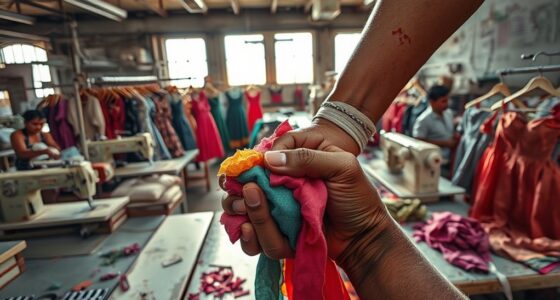The EU’s Circular Textile Strategy will transform fashion by encouraging you to choose sustainable, recycled, and biodegradable fabrics while industry practices shift toward eco-friendly sourcing and recycling innovations. It promotes transparency, reducing waste and extending product lifecycles. As brands adopt these sustainable methods, you’ll see more eco-conscious options and responsible production. Keep exploring how this strategy is leading the way to a greener, more circular fashion industry—everything is headed toward a more sustainable future.
Key Takeaways
- Promotes sustainable sourcing and recycling innovations to reduce reliance on raw materials and textile waste.
- Encourages transparency and accountability among brands and suppliers for environmental impacts.
- Drives industry shifts toward circular design, reusability, and recyclability of textiles.
- Empowers consumers to adopt sustainable behaviors and participate in reuse and recycling programs.
- Sets a global example, transforming fashion into a greener, more circular industry across Europe.

Have you ever wondered how the European Union plans to transform its textile industry? The EU’s Circular Textile Strategy aims to reshape how clothing is produced, used, and recycled, focusing on sustainability and innovation. At its core, the strategy emphasizes sustainable material sourcing, ensuring that textiles are made from environmentally friendly, renewable, and ethically sourced materials. Instead of relying on virgin resources that deplete natural ecosystems, the EU encourages companies to switch to recycled fibers and biodegradable fabrics. This shift not only reduces the environmental footprint but also promotes a circular economy, where textiles are designed with their entire lifecycle in mind. You’ll find that brands will increasingly prioritize suppliers committed to sustainable practices, making transparency and accountability essential to the future of fashion in Europe.
The EU’s Circular Textile Strategy promotes sustainable sourcing, recycling innovation, and transparency to transform fashion’s future in Europe.
Alongside sustainable sourcing, the EU is heavily investing in innovative recycling techniques. These advancements aim to turn old textiles into new, high-quality materials, effectively closing the loop in textile production. Instead of discarding worn-out garments in landfills or incinerating them, the strategy promotes technologies like chemical recycling, which breaks down textiles into their basic fibers and remakes them into new fabrics. Mechanical recycling, another technique, involves shredding textiles into fibers that can be spun into yarns again. These methods are fundamental for reducing waste and minimizing the reliance on raw materials. By pushing forward research and development in this field, the EU hopes to make recycling a standard part of the industry, encouraging brands and manufacturers to adopt these methods at scale. Additionally, fostering innovative recycling methods will be crucial for future industry standards.
The strategy also envisions a future where consumers play a more active role in sustainability. You’ll be encouraged to buy longer-lasting garments, care for your clothes properly, and participate in reuse and recycling programs. Companies will be required to provide clearer information about the environmental impact of their products, empowering you to make more sustainable choices. This extensive approach aims to create a circular economy where textiles are continuously reused, repurposed, or recycled, dramatically reducing waste and pollution.
Ultimately, the EU’s Circular Textile Strategy is designed to stimulate innovation, foster sustainable practices, and shift the industry toward a more responsible model. It’s not just about changing how clothes are made; it’s about transforming the entire lifecycle of fashion. By prioritizing sustainable material sourcing and pioneering innovative recycling techniques, the EU is setting a global example for a greener, more circular future in fashion. As a consumer, you’ll see these changes reflected in the products you buy, the brands you support, and the impact you can have in helping shape a sustainable textile industry.
Frequently Asked Questions
How Will the Strategy Impact Small and Medium-Sized Fashion Businesses?
You’ll need to adapt your supply chain to meet new sustainability standards, which might mean more eco-friendly sourcing and recycling processes. The strategy offers innovation funding that can help you develop sustainable materials and practices, giving you a competitive edge. Embracing these changes can boost your brand’s reputation and open up new markets, but it also requires proactive planning and investment to stay ahead in the evolving fashion landscape.
What Are the Specific Deadlines for Compliance Under the New Regulations?
You need to meet specific deadlines for compliance, including implementing textile recycling processes and ensuring your supply chain adheres to new standards. By 2025, you’ll be expected to demonstrate increased use of recycled fibers and transparent supply chain practices. These deadlines aim to encourage sustainable textile recycling and reduce environmental impact, so start planning now to align your business operations with these regulations and stay ahead in the evolving fashion industry.
How Will Consumer Behavior Be Influenced by These Sustainability Measures?
Did you know that 66% of consumers now prioritize sustainability in their purchasing decisions? With increased consumer awareness driven by the EU’s measures, you’ll likely see a shift in behavior. As awareness grows, you’ll feel more inclined to choose eco-friendly options, encouraging brands to adopt sustainable practices. These measures push you to contemplate the environmental impact of your purchases, fostering responsible consumption and influencing broader market trends.
Are There Any Financial Incentives for Adopting Circular Practices?
Yes, there are financial incentives for adopting circular practices. You can access government grants and tax incentives that support sustainable initiatives, making it more affordable to implement circular strategies. These incentives aim to encourage you to reuse, recycle, and design with sustainability in mind. By taking advantage of these financial benefits, you can reduce costs and demonstrate your commitment to eco-friendly fashion, aligning your business with EU sustainability goals.
How Will the Strategy Address the Issue of Textile Waste Exports?
You might think textile waste exports are unstoppable, but the EU’s strategy aims to curb this. It proposes strict export restrictions on textile waste to prevent environmentally harmful disposal in third countries. By enforcing these limits, the EU encourages better waste management within member states and reduces global textile waste pollution. This approach makes you realize that the strategy actively tackles textile waste export issues and promotes sustainable practices across Europe.
Conclusion
By embracing the EU’s circular textile strategy, you’ll help reduce waste and promote sustainable fashion. Imagine a brand that designs clothes for easy recycling, turning old garments into new ones. This approach not only minimizes environmental impact but also sets a new standard for innovation. As more companies adopt such practices, you’ll see a shift toward truly sustainable fashion, making a positive difference for both the planet and future generations.









